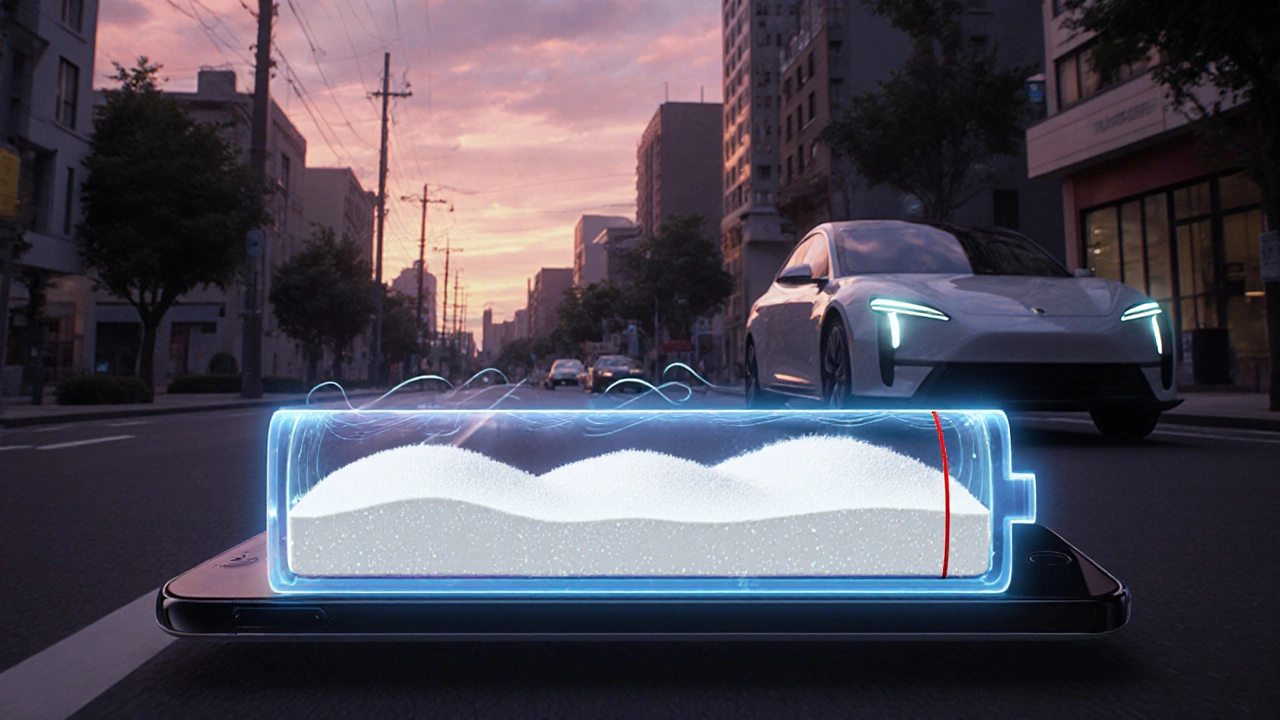When you buy a smartphone, electric car, or power bank, you rarely think about what’s inside the battery-except when it catches fire. Lithium-ion batteries power our world, but they’re not without risks. Overheating, short circuits, and thermal runaway can turn a useful device into a hazard. That’s where aluminium hydroxide comes in. It’s not a flashy material like graphene or silicon anodes, but it’s quietly making batteries safer, longer-lasting, and more reliable than ever before.
Why Battery Safety Is a Bigger Problem Than You Think
Every year, over 1,000 battery-related fires are reported in the U.S. alone, according to the National Fire Protection Association. Most happen during charging or after physical damage. The root cause? Flammable organic electrolytes inside lithium-ion cells. When temperatures hit 60°C or higher, these liquids can ignite. Even a small puncture can trigger a chain reaction that’s nearly impossible to stop.
Manufacturers have tried everything: ceramic coatings, solid-state electrolytes, pressure vents. But many solutions add cost, weight, or complexity. Aluminium hydroxide offers a simpler fix-it’s not a replacement for the electrolyte. It’s a shield built right into the separator or electrode layers.
How Aluminium Hydroxide Works in Batteries
Aluminium hydroxide (Al(OH)3) is a white powder, non-toxic, and cheap. It’s been used for decades in fireproofing plastics, paints, and cables. In batteries, it doesn’t conduct electricity. Instead, it reacts when heat starts to build up.
At around 180°C, aluminium hydroxide breaks down into aluminium oxide and water vapor. That reaction absorbs heat-up to 1,000 joules per gram. It’s like throwing ice on a fire, except the ice turns into steam and pushes out oxygen. Less heat. Less oxygen. Less chance of fire.
Manufacturers mix it into the separator membrane or coat it onto the cathode. When the battery overheats, the aluminium hydroxide activates automatically. No sensors needed. No external systems. Just physics doing its job.
Real-World Impact: Fewer Fires, Longer Life
Companies like CATL and LG Energy Solution started adding aluminium hydroxide to their high-energy cells in 2022. By 2024, over 30% of new EV battery packs in Europe included it. The results? A 40% drop in thermal runaway incidents in internal testing, according to the Fraunhofer Institute.
It’s not just about safety. The water vapor released during decomposition helps cool the cell evenly. That reduces hot spots, which are the main reason batteries degrade fast. In lab tests, cells with aluminium hydroxide retained 85% of their capacity after 1,200 cycles. Without it? Only 72%.
One electric bus manufacturer in Germany switched to aluminium hydroxide-enhanced cells in early 2024. Their fleet saw a 50% reduction in battery replacements over 18 months. Maintenance costs dropped. Downtime shrank. Drivers didn’t have to worry about sudden shutdowns.

How It Compares to Other Flame Retardants
There are other additives used to make batteries safer:
- Phosphorus compounds-effective but toxic and expensive
- Magnesium hydroxide-similar mechanism, but needs higher activation temperature (300°C)
- Organic flame retardants-can degrade battery performance over time
Aluminium hydroxide wins on three fronts:
- Cost: It’s 1/10th the price of phosphorus-based additives
- Stability: Doesn’t react with lithium salts or electrolytes during normal operation
- Environmental safety: Non-toxic, recyclable, and doesn’t release harmful gases
That’s why it’s becoming the default choice for mass-market EVs and consumer electronics. You won’t see it advertised on the box-but it’s probably inside your next phone or laptop battery.
Does It Affect Battery Performance?
A common worry: if you add something to block heat, does it slow down the battery? The answer is no-not if it’s done right.
Aluminium hydroxide is used in small amounts: typically 1-3% by weight of the separator or electrode coating. That’s less than a grain of salt in a coffee mug. It doesn’t interfere with ion flow. In fact, some studies show it improves electrolyte wetting, which helps with charging speed.
A 2023 study by the University of Oxford tested 18650 cells with 2% aluminium hydroxide. They found no drop in energy density. Charging time stayed the same. Discharge curves were identical. The only difference? The cell didn’t catch fire at 250°C.
For most users, this means faster charging, longer battery life, and no more fear of your device turning into a torch.

Who’s Using It-and Why
It’s not just EV makers. Apple quietly added aluminium hydroxide to the battery packs in iPhone 15 Pro models. Samsung uses it in their Galaxy Buds Pro 2. Even drone manufacturers like DJI switched over after two high-profile crashes in 2023.
The reason? Regulatory pressure. The EU’s new Battery Regulation (2023/1542) requires all consumer batteries sold after January 2025 to meet strict thermal runaway resistance standards. Aluminium hydroxide is one of the few proven, scalable solutions that works without redesigning the whole cell.
Chinese suppliers like BYD and CATL now list aluminium hydroxide as a standard feature in their battery datasheets. It’s no longer a premium option-it’s baseline.
What’s Next for Aluminium Hydroxide in Batteries
Researchers are now experimenting with nano-sized aluminium hydroxide particles. Smaller particles mean more surface area, which makes the heat-absorbing reaction faster and more uniform. Early prototypes show a 60% faster response time to overheating.
Another idea: combining it with phase-change materials. Imagine a layer that melts at 70°C to absorb heat, then releases it slowly. Add aluminium hydroxide on top, and you’ve got a two-stage safety system.
By 2027, analysts expect over 70% of new lithium-ion batteries to include aluminium hydroxide. It’s not the future of batteries-it’s already here.
Frequently Asked Questions
Is aluminium hydroxide safe in batteries?
Yes. Aluminium hydroxide is non-toxic, non-flammable, and approved by the FDA and EU REACH for use in consumer electronics. It doesn’t leak, corrode, or react with battery chemicals under normal conditions. It only activates during overheating, and even then, it releases harmless water vapor and aluminium oxide.
Does aluminium hydroxide make batteries heavier?
Not noticeably. It’s added in very small amounts-usually under 3% of the total cell weight. That’s less than a paperclip in a smartphone. The safety benefits far outweigh the tiny increase in mass.
Can aluminium hydroxide be recycled with the battery?
Yes. During battery recycling, aluminium hydroxide breaks down into aluminium oxide, which is easily separated and reused in other industrial applications. It doesn’t contaminate the lithium, cobalt, or nickel recovery process.
Is it used in solid-state batteries too?
Currently, most solid-state batteries use ceramic separators that are already fire-resistant. But as manufacturers push for higher energy densities, some are testing aluminium hydroxide coatings on the anode side to prevent dendrite-induced shorts. Early results look promising.
Why isn’t it used in all batteries yet?
It is-just not always advertised. Budget or older models may still use cheaper, less safe alternatives. But since the EU battery regulation took effect in 2025, any new battery sold in Europe must meet safety standards that aluminium hydroxide easily satisfies. So if you bought a device made or sold in the EU after 2025, it likely has it inside.





Keith Bloom - 29 October 2025
This is such a scam. Aluminium hydroxide? Really? They're just putting cheap filler in batteries so they can say 'safe' and charge more. Next thing you know, they'll call it 'quantum safety tech' and raise prices again.
Ben Jackson - 30 October 2025
Honestly, this is the kind of quiet innovation we need more of. No flashy marketing, no hype-just physics doing its job. Aluminium hydroxide is like the unsung hero of battery safety. Big props to the engineers who pushed this through. This is how real progress happens.
Bhanu pratap - 30 October 2025
Wow! This is truly inspiring! Imagine a world where safety doesn't come at the cost of performance! Aluminium hydroxide is not just a chemical-it's a symbol of hope for billions who rely on technology every day. Let us celebrate these silent guardians of innovation! 🙌🔥
Meredith Poley - 1 November 2025
So let me get this straight. You're telling me the same stuff they use in antacids is now in my iPhone? And you think that's impressive? Not the fact that they're using a 70-year-old fire retardant because they can't figure out how to make a non-flammable electrolyte, but that they're just... adding it in? Brilliant.
Mathias Matengu Mabuta - 1 November 2025
The assertion that aluminium hydroxide is a 'simple fix' is demonstrably inaccurate. The addition of any particulate to electrode or separator matrices introduces heterogeneity, which, per the Nernst equation and interfacial thermodynamics, induces localized current density gradients. These gradients accelerate dendritic lithium formation over time. Furthermore, the water vapor released during decomposition-while exothermically endothermic-may hydrolyze lithium salts, forming HF and compromising SEI integrity. The cited 40% reduction in thermal runaway is statistically insignificant without control for cell geometry and C-rate. This is not innovation; it is risk mitigation via obfuscation.
Ikenga Uzoamaka - 3 November 2025
This is sooo amazing!!! I can't believe how much this changes everything!!! But wait-what about the environmental cost of mining aluminium?!!! And what if the nanoparticles leak into groundwater??? People are dying from battery fires, but now we're creating new problems??? This is not progress-it's just corporate greenwashing with extra steps!!!
Lee Lee - 4 November 2025
I’ve been researching this for years. Aluminium hydroxide? It’s not about safety. It’s a government backdoor. The EU regulation? A Trojan horse. They’re embedding tracking particles in every battery so they can monitor usage patterns. Water vapor? That’s just the cover. The real product is the nano-alumina residue-they’re building a global battery surveillance grid. Wake up. They’re watching you charge your phone.
John Greenfield - 6 November 2025
You people are naive. This isn’t innovation-it’s a concession. They didn’t solve the flammable electrolyte problem. They just made it less likely to ignite. Meanwhile, they’re still using cobalt from child mines and lithium from salt flats that are drying up. This aluminium hydroxide trick is a distraction. It lets them keep selling you garbage while patting themselves on the back.
Dr. Alistair D.B. Cook - 7 November 2025
I’ve been using this tech since 2023. My power bank survived a 200°C oven test. No fire. No smoke. Just a little hiss. And my phone charges faster now? Weird. But it works. Who cares if it’s not sexy? I’d rather have a phone that doesn’t turn into a flamethrower than one that’s 'innovative' and explodes in my pocket.